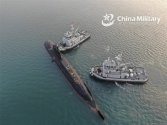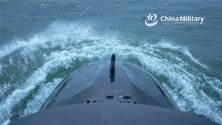I have nothing technical to add, but I'm always surprised when certain armchair generals outright dismiss the PLAN SSK fleet. Not sure if they understand what the fleet is for.
You are using an out of date browser. It may not display this or other websites correctly.
You should upgrade or use an alternative browser.
You should upgrade or use an alternative browser.
Yuan Class AIP & Kilo Submarine Thread
- Thread starter Jeff Head
- Start date
They draw their conclusions on the omnipotence of US subs and ASW. There are many people who think the US could stop landings on Taiwan with a few LA class subs. I usually post just a clown picture as my answer to them.I have nothing technical to add, but I'm always surprised when certain armchair generals outright dismiss the PLAN SSK fleet. Not sure if they understand what the fleet is for.
antiterror13
Brigadier
Some lump the curved sail boats as part of the 039B, or variants of such. 039C is referred to as the new board with the A26 style sail. IMO, most if not all the older sail 039B has been refitted into the new sail configuration and may also have internal and machinery improvements. Remember at some point they stopped making the 039B or slowed down production to one boat a year before releasing the new angled sail variant. I believe during this 'pause', the shipyards were still busy, not making new boats, but busy refitting older squared sailed ones to the new curved sail standard. You hardly or don't see the older squared sail 039B anymore, and it's because I believe that have all been refitted to the new standard. They also get new coatings and stuff like that, and come out indistinguishable from the brand new boats.
Also I suspect at some point they may have been converted to Lithium Ion or at least a few boats were for test reasons first, then moving on to general deployment.
Considering China now dominating Li Ion battery technologies and production, I would be very surprised if they haven't done so (testing or even in service with battery). China currently in the top of the technologies of sodium-ion battery (SIB), so SIB may be the choice for Subs battery, cheaper, safer even less density than the top Li Ion battery. Or China may go for both Li Ion and SIB
They draw their conclusions on the omnipotence of US subs and ASW. There are many people who think the US could stop landings on Taiwan with a few LA class subs. I usually post just a clown picture as my answer to them.
I'd be very surprised if any US submarines could survive in the Taiwan Straits.
These are shallow waters which will be full of Chinese warships, helicopters and aircraft.
I suspect they would make the area a free fire zone where any possible submarine contact can automatically be assumed to be hostile.
And there's no reason they couldn't cover the area with active sonar, given the number of ships and aircraft above
Considering China now dominating Li Ion battery technologies and production, I would be very surprised if they haven't done so (testing or even in service with battery). China currently in the top of the technologies of sodium-ion battery (SIB), so SIB may be the choice for Subs battery, cheaper, safer even less density than the top Li Ion battery. Or China may go for both Li Ion and SIB
There's a specification sheet for a Winston Battery WB-LYP10000AHA battery pack from 2014, which markets itself as used in the Yuan.
It's listed as 31MWh with a weight of 335tonnes using Lithium Iron Phosphate batteries. That is much higher performance than previous generation lead-acid batteries.
Also, Lithium Iron Phosphate batteries are safer than lead-acid batteries because they can't release chlorine gas when exposed to seawater. And with lead-acid batteries, you could get a gas explosion if enough chlorine gas is produced quickly.
So why wouldn't you go with Lithium Iron Phosphate batteries, given an inherently safer battery chemistry which cannot produce explosions or release toxic gases when exposed to seawater, whilst also providing a lot more performance.
I expect these batteries have been used in the Yuan for years now.
shop.gwl.eu/blog/LiFePO4/Winston-Battery-WB-LYP10000AHA-in-large-submarines.html
View attachment 82535
antiterror13
Brigadier
There's a specification sheet for a Winston Battery WB-LYP10000AHA battery pack from 2014, which markets itself as used in the Yuan.
It's listed as 31MWh with a weight of 335tonnes using Lithium Iron Phosphate batteries. That is much higher performance than previous generation lead-acid batteries.
Also, Lithium Iron Phosphate batteries are safer than lead-acid batteries because they can't release chlorine gas when exposed to seawater. And with lead-acid batteries, you could get a gas explosion if enough chlorine gas is produced quickly.
So why wouldn't you go with Lithium Iron Phosphate batteries, given an inherently safer battery chemistry which cannot produce explosions or release toxic gases when exposed to seawater, whilst also providing a lot more performance.
I expect these batteries have been used in the Yuan for years now.
shop.gwl.eu/blog/LiFePO4/Winston-Battery-WB-LYP10000AHA-in-large-submarines.html
View attachment 82535
I hope so and Chinese battery technology in 2022 is much more advanced than 2014. In 2022, Chinese battery technology is leading in the world, see CATL and BYD
re: current chinese battery production, do you think this assessment is outdated? (not trying to be polemic, I'm not knowledgeable about the topic and just genuinely interested)Considering China now dominating Li Ion battery technologies and production, I would be very surprised if they haven't done so (testing or even in service with battery). China currently in the top of the technologies of sodium-ion battery (SIB), so SIB may be the choice for Subs battery, cheaper, safer even less density than the top Li Ion battery. Or China may go for both Li Ion and SIB
China has the “advantage” in low-end lithium battery products, but is “heavily reliant” on imports for high-end battery separator materials. Japanese firms Asahi Kasei and Tonen [now owned by Japan’s Toray Industries] dominate high-end lithium battery separator materials, and Japanese companies such as Showa Denko “monopolize” aluminum-plastic films for these batteries, with 90 percent market share in China.
The PRC is already among the best in the world at the dry process for separator manufacturing, and some PRC firms have “mastered” the wet process, but still “depend mainly on imports” for core production equipment. ()
the report was compiled by a us entity, but the info in it was sourced by articles in Science and Technology Daily (科技日报) in 2018.
ever since I saw the post here, I've been trying to understand how things have changed from 2018
"Li-ion" is a crazy idea for a Submarine, I don't think the Chinese are as crazy as the Japanese, so to speak and express it.
A different matter is "LiFePO4" and "Sodium" and other possibilities that I do not know because this field of Batteries right now (2020-2030) is living a Revolution.
---
Edit
Sorry. I now realize that the terminology is confusing as the term "Li-ion" is used generically and includes "LiFePO4".
A different matter is "LiFePO4" and "Sodium" and other possibilities that I do not know because this field of Batteries right now (2020-2030) is living a Revolution.
---
Edit
Sorry. I now realize that the terminology is confusing as the term "Li-ion" is used generically and includes "LiFePO4".
Last edited:
antiterror13
Brigadier
re: current chinese battery production, do you think this assessment is outdated? (not trying to be polemic, I'm not knowledgeable about the topic and just genuinely interested)
China has the “advantage” in low-end lithium battery products, but is “heavily reliant” on imports for high-end battery separator materials. Japanese firms Asahi Kasei and Tonen [now owned by Japan’s Toray Industries] dominate high-end lithium battery separator materials, and Japanese companies such as Showa Denko “monopolize” aluminum-plastic films for these batteries, with 90 percent market share in China.
The PRC is already among the best in the world at the dry process for separator manufacturing, and some PRC firms have “mastered” the wet process, but still “depend mainly on imports” for core production equipment. ()
the report was compiled by a us entity, but the info in it was sourced by articles in Science and Technology Daily (科技日报) in 2018.
ever since I saw the post here, I've been trying to understand how things have changed from 2018
in 2018 perhaps true that Chinese companies have “advantage” in low-end lithium battery products but now in 2022, Chinese basically very dominant in both low and high end. I am sure China importing some parts from Japan, but it doesn't mean China can make it yourself, especially after the Trump nightmare in 2019 ... the game has changed totally


